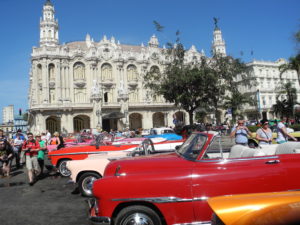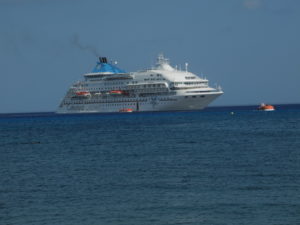
Most Americans will no longer be able to view Havana’s famous classic cars. Photo by Clark Norton
A little over three years ago, I was able to travel to Cuba on a cruise ship and write about my trip for a AAA publication in Colorado and a cruise magazine, as well as for this blog.
The cruise ship was mostly populated by Americans traveling on a “people-to-people” program run by the Fund for Reconciliation and Development, a Riverhead, New York-based organization promoting U.S.-Cuba relations.
The cruise included lectures on Cuban culture, tours of historic sites, a visit to the famed Tropicana nightclub, and other activities, such as visiting a privately owned restaurant as well as various Hemingway haunts around Havana.
And yes, we did meet many Cubans along the way, including government tour guides who spoke remarkably candidly about how they surreptitously supplemented their meager official incomes.
Restrictions had loosened
Such educational programs were one of 12 special dispensations allowing Americans to travel individually to Cuba, and cruise ships were a very popular way of getting there and then getting around the island.
Some Canadians and Europeans were also on board, but they had been free to visit Cuba for years.
Americans, on the other hand, had been highly restricted in travels to Cuba for decades before the Obama Administration loosened things up. Americans flocked to the island, curious about the long-forbidden country just 105 miles south of Key West.
Baby boomers, especially, rushed to see those amazing classic cars from the 1960s that the Cubans have kept running despite decades-long embargoes on replacement parts.
The Cubans, we discovered, are extraordinarily enterprising people in the face of incredible economic hardships. Tourism has been the driving force in their economy for some years now, and things were looking up with the arrival of the Americans.
Tour guides, restaurant owners, everyday folks who rented out their bedrooms to American tourists, and other Cubans involved in tourism have been putting hard currency in their pockets.
Well, it was good while it lasted.
No Mas, Amigos
As of today (June 5 as I write this), the Trump Administration has decreed that “people-to-people” programs are no longer on the permitted list for Americans traveling to Cuba. And, just for good measure, no more cruise ships, either. That pretty much puts the kibosh on any sort of pure U.S tourism to the island.

The Celestyal Crystal, the ship I took to Cuba three years ago. Photo by Clark Norton
If you hadn’t bought your ticket to Cuba by June 4 — the public was given just a few hours’ notice that day — you were out of luck. Cruises have been cancelled. People-to-people exchanges are no more.
The Administration offered up a couple of explanations for their action: the Cubans were supporting the Maduro regime in Venezuela, and they were shocked, shocked! to learn that the Cubans were running an oppressive Communist government so close to our shores.
I think we can discount the second reason, since, after all, the President is quite chummy with various dictators around the globe, including his bromance with the butcher of the Peoples Republic of North Korea.
So it boils down to trying to add pressure to scare off any friends of Maduro (of whom, by the way, I’m no admirer). The Administration has so far failed in its efforts to dislodge the Venezuelan leader, so why not punish ordinary Cubans and Americans, toss the whole thing up in the air like confetti, and see where it lands?
It’s much like Trump’s threatened Mexico tariffs — punish American farmers, consumers, and others to somehow get Mexico to stop the flow of Central American refugees at the border. That makes so much sense that even Trump toadies like Senate Majority Leader Mitch McConnell are reaching for their smelling salts.
I admit, I’m biased — biased in favor of freedom to travel. If Americans want to travel to Cuba, they should be allowed to travel to Cuba (with, or preferably without, the pretense of people-to-people exchanges).
Same with Iran, Venezuela, or any other country on Trump’s enemies’ list that still allows American visitors. If it’s Cuba today, who knows which nations will be on the blacklist tomorrow?












6 Responses to Returning to the Dark Ages on Cuba